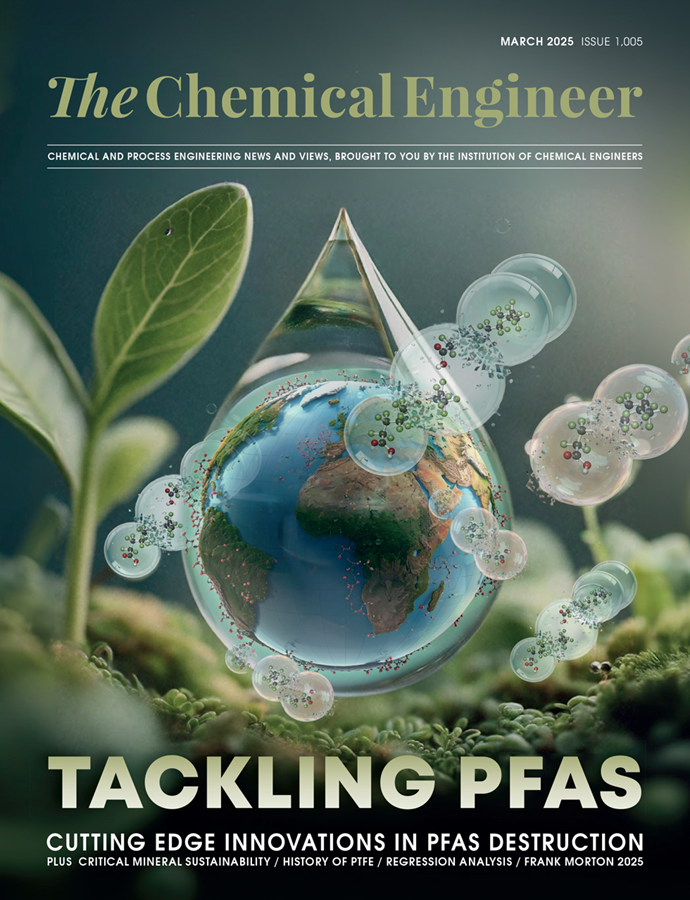Unravelling PFAS: Challenges and Advances in Contaminant Remediation
From industrial applications to environmental concerns, Jim Fenstermacher, Pradeep Shukla, and Prashant Srivastava explore the chemistry of PFAS, emerging capture technologies, and the ongoing efforts to mitigate their impact
Quick read
- PFAS Challenges: PFAS, due to their chemical stability and low surface energy, are difficult to capture and destroy, making effective remediation efforts challenging. Their presence in the environment, especially in groundwater and soil, complicates both concentration and destruction efforts
- Innovative Remediation Technologies: Various methods, including in-situ treatment, adsorption, and filtration technologies like nanofiltration and reverse osmosis, are being explored to capture and concentrate PFAS. However, issues like saturation, regeneration, and competition with other substances hinder their long-term effectiveness
- Future Remediation Strategies: Successful PFAS remediation will require a combination of techniques tailored to specific site conditions. Strategies must balance cost-effectiveness, environmental protection, and community impact, with long-term monitoring essential for achieving reliable and sustainable results
A GROUP of man-made chemicals, per- and polyfluoroalkyl substances (PFAS) have been widely used in various industrial, commercial, and consumer applications due to their resistance to heat, water, and oil.
However, concern over PFAS has sparked a global effort to develop effective solutions for remediating and managing contaminated sites.
Here, we explore the physical chemistry of PFAS, recent advancements in capture technologies, and the challenges of treating and remediating contaminated sites.
A few definitions
Our discussion of PFAS is focused on fluorosurfactants – molecules with alkyl chains that are fully or partially fluorinated and contain a terminal functional group that imparts an ionic charge and provides distinct performance properties. A few examples are shown in Figure 1. By some definitions, the term PFAS can refer to over 7m different chemical compounds. However, only a small subset is analytically quantifiable due to lack of reference standards.1

The desirable properties
The single property that all fluorosurfactants (and fluoropolymers) possess is low surface energy. For liquids, this makes them highly effective wetting agents, improving spreadability and adhesion to solid surfaces or immiscible liquids, such as aqueous film-forming foam on oil. In solids, this low surface energy provides excellent oil and water repellency, enhancing stain resistance in carpets and furnishings and improving the all-weather performance of outerwear and weatherproof coatings.2
…and less desirable properties
The low surface energy of PFAS comes from the high electronegativity (the tendency of an atom to attract electrons towards itself) of the fluorine atom. As the most electronegative element in the periodic table, once fluorine obtains an additional electron through bonding with another atom it becomes nearly as inert as neon, the element to its immediate right on the periodic table. It is this inertness that provides fluorocarbons their very low surface energy. This same low surface energy and chemical stability, however, makes PFAS difficult to capture and destroy – providing an initial insight into the challenges associated with effective PFAS treatment.
Despite their usefulness, PFAS are undesirable in industrial and municipal settings, where they must be removed from waste streams before discharge, and in the environment. They can be found in air, groundwater, surface water, soil, and in humans and other animals. For discussion, assume PFAS concentrations range from 10³ to 10⁶ ng/L in industrial settings and 10² to 10⁴ ng/L in impacted environmental settings. In both cases, the goal is to reduce concentrations to 10⁰ to 10¹ ng/L, requiring a reduction of roughly 3 to 5 orders of magnitude or more. This is significant because the cost of destruction or long-term storage (eg landfill disposal) increases almost linearly with volume, making the pre-concentration of contaminated water a crucial economic factor. In addition, the kinetics of degradation reactions at such low concentrations can be impractical, further underscoring the need for an upstream PFAS concentration step.
These two steps, concentration and destruction (see Figure 2), are both working against thermodynamics – dispersion and entropy in the first case, Gibbs free energy and breaking the carbon-fluorine bond in the second – providing a second insight into the difficulties chemical engineers face in developing and applying effective technologies for PFAS treatment.

Methods of capturing and CONCENTRATING the PFAS
Technical options for capturing or concentrating PFAS generally fall into two broad categories: removal via size exclusion (eg nanofiltration or reverse osmosis) and removal through adsorption processes. Nanofiltration can remove long-chain PFAS, which have molecular weights ranging from roughly 300 to 900 g/mol, while reverse osmosis is generally required if filtration technology is to be used for removal of long, short and ultra-short PFAS (ie PFAS with only 1- to 3-carbon perfluoro chains). Both filtration technologies generate membrane “reject” streams, caused by the accumulation of non-filtered waste on the upstream side of the membrane. These streams are challenging to further concentrate without compromising membrane integrity, discharge water quality, or both. Depending on multiple factors, the reject stream can be anywhere from 10 to 50% of the incoming flow.
Adsorption can produce very clean water streams when fresh adsorbent materials are used. However, regeneration of adsorbent to return the media to a “pristine” fresh sorbent is very challenging. For example, residual PFAS remaining on the adsorbent after regeneration may be detected in the product stream, as adsorbates can desorb when displaced by more strongly binding species. Even when using chemical regenerants, such as methanol or ethanol, achieving the required effluent quality has proven challenging. Consequently, many current adsorption processes for PFAS use a once-through system where the adsorbent is disposed of after a single use. Under controlled test conditions using clean water spiked with PFAS, carbon beds can typically treat 15,000 to 30,000 bed volumes before analyte breakthrough. However, in practice, these values can be significantly reduced when groundwater contains additional organic and inorganic species that compete with PFAS for adsorption sites.
Ion exchange operates similarly to activated carbon adsorption, following a capture-regeneration cycle to attain desired discharge criteria. However, the key difference between the two lies in the mechanism of action. Ion exchange takes better advantage of the electrostatic attraction of a target molecule and is driven more by the charge density of the PFAS head group. In contrast, adsorption is driven more by the hydrophobic nature of the PFAS tail group, which causes the PFAS to leave the water phase and bind to a solid surface. This can make ion exchange a more suitable process for separating PFAS species with lower hydrophobicity, such as short-chain molecules like perfluorobutanoic acid (PFBA) or perfluorobutanesulfonic acid (PFBS). Anion exchange resins can be prone to saturation at high total dissolved solids (TDS) levels, particularly in the presence of excess sulfate, nitrate, perchlorate, or chlorides. Like activated carbon adsorption, ion exchange faces issues with the adsorption/desorption cycle. While regenerable resins are available, their exchange capacity is typically lower than non-regenerable counterparts, which can limit long-term use. Aggressive regeneration methods, such as a combination of ionic solutions and methanol, have been used by some PFAS treatment providers, but these processes produce waste liquids with high TDS, methanol, and residual PFAS, complicating further treatment or disposal of secondary wastes.
Adsorption at the air-water interface (ie foam fractionation) has the rather elegant benefit that there is no media to regenerate – and from an environmental sustainability perspective, has zero media manufacturing and disposal burden. Foam fractionation takes advantage of the surfactant properties of PFAS (ie tendency to agglomerate at the air-water interface and form foams), and is relatively insensitive to co-contaminants, such as organic and inorganic substances in “dirty” waste streams like landfill leachate. Foam fractionation can reach concentration factors of ~1,000 to 100,000 (ie 100,000 L of a waste stream at 20 ng/L PFAS would be reduced to 10 L volume and a concentration of 200,000 ng/L). As with any adsorption process, treatment efficiency decreases with lower hydrophobicity. However, various additives have been used to enhance the hydrophobicity and removal efficiency of short-chain and some ultra-short PFAS.
Destroying the PFAS molecule
Technical options for destruction of PFAS will be discussed in another article in this issue (see Breaking Down Barriers). However, the degradation of the PFAS molecule also remains an active area of research, both academically and commercially. Accordingly, the readiness and practicality of these technologies for field deployment vary widely.
Site remediation
Revisiting pump-and-treat
Remediating the contaminated site has been an engineering activity for close to five decades.3 Early groundwater remediation approaches primarily focused on extracting groundwater from the subsurface and treating it through a treatment system, known as pump-and-treat. This method is inefficient for removing contaminants from the environment for two key reasons. First, the transport and storage of contaminants within a plume over time can make it difficult to effectively capture and remove them. Second, using water as a medium for transferring contaminant mass is inherently inefficient, as it may not effectively target or remove all the contaminants present. Starting in the late 1990s, a new wave of innovation brought in-situ treatment methods to the forefront, placing remedial treatment chemistry directly into the subsurface. Whether biologically mediated, non-biological, or thermal, these approaches have proven highly effective in destroying contaminant mass in place, overcoming the limitations of earlier methods that attempted to physically recover contaminants and treat them in above-ground systems.
While PFAS share many characteristics with classic contaminants, such as dissolved-phase movement and retention in low-permeability zones, they also pose unique challenges.4 As surfactants, PFAS molecules tend to self-assemble and accumulate at the air-water interfaces within the unsaturated groundwater capillary zone, which can extend up to a metre or more. The capillary zone forms due to the surface tension of water as it interacts with the solid surfaces of soil particles, making soil a porous medium. This zone can serve as a critical storage area, continuously accumulating contaminant mass as PFAS migrate downward through the soil during rainfall. However, it releases contaminant mass at a slower rate, primarily controlled by diffusion. Below the capillary zone, groundwater moves through fully saturated soils. However, within the capillary zone itself, groundwater movement is minimal, occurring only during seasonal fluctuations or when rainwater seeps into the soil and reaches the groundwater table. This means that increasing the rate of groundwater advection (eg by increasing the pumping rate) will have little to no effect on accelerating the mass transfer of PFAS from the capillary zone, presenting a challenge to efficient PFAS remediation through pumping.

Locking contaminants in place
In some cases, in-situ capping can be a suitable remediation approach, particularly in areas with deep groundwater levels or in jurisdictions where potential impacts to groundwater are of less concern. This technique involves placing a barrier over impacted soils to mitigate the spread of PFAS to underlying soil and groundwater, by inhibiting the percolation of rainwater through the impacted soils beneath the barrier. It is a current practice that has been used in locations where excavation is impractical, or soil impacts are shallow and can be supplemented by regular groundwater pumping to manage water table fluctuations.
Similarly, soil amendments are being used more frequently to slow the mobilisation of PFAS compounds. By adding materials such as powdered activated carbon, biochar, modified clays, or iron-oxide compounds, the migration and bioavailability of PFAS can be reduced. However, the long-term stability of these additives remains a concern, as saturated sorption sites may lead to desorption and remobilisation of PFAS, ultimately resulting in potential recontamination.
Colloidal activated carbon injection
Subsurface injection of colloidal-activated carbon is a commercially available technology that introduces a sorption-based treatment to slow PFAS migration. However, as with any sorption method, the principles of adsorption (eg reversibility, saturation, and eventual breakthrough) apply. Additionally, activated carbon may preferentially be emplaced into high-permeability zones within the aquifer, which may not coincide with areas where the majority of PFAS mass is located. As PFAS come into contact with the colloidal activated carbon through advection and diffusion, other organic materials may compete for adsorption sites, potentially compromising the long-term effectiveness of the treatment. If breakthrough occurs during the site monitoring period, additional carbon can be added to further slow migration.
Thermal desorption
Thermal desorption is also a commercially available technology that involves applying heat directly to impacted soils to attain subsurface temperatures in excess of 350°C, volatilising and capturing PFAS for downstream destructive treatment. Thermal desorption can be applied either above-ground, in piles of excavated soil, or below-ground, where it encourages PFAS migration from impacted zones to recovery points, allowing the contaminant mass to be brought to the surface for treatment. In the in-situ process, care must be taken to avoid recondensing PFAS at locations where temperatures are too low to volatilise them. Additionally, excessive temperatures may cause some PFAS to break down, so capturing both existing and generated ultra-short PFAS should be carefully considered during system design.
A greener approach
A potentially greener solution to address PFAS migration is constructed wetlands. These systems combine phytoremediation – specifically phytoextraction – and applied sorbent barriers to selectively impede the mobility of PFAS and facilitate their removal. The phytoremediation aspect involves the uptake of PFAS compounds through plant roots, while the sorbents (acting also as soil additives), typically composed of substrates such as activated carbon or clay, provide a physical medium for PFAS adsorption. This synergistic approach hinders the movement of PFAS through the water and soil, allowing the mass removal by plants.
Although research is still in its preliminary stages, several aquatic and emergent plant species have demonstrated potential for PFAS uptake through absorption and entrapment mechanisms. To the knowledge of the authors this technique has not been deployed at scale in the field. However, notable species include Myriophyllum aquaticum (water primrose), Schoenoplectus spp. (bulrushes), and Phragmites australis (common reed), which have been studied for their capacity to bioaccumulate PFAS compounds.
Site remediation: Practical considerations and final thoughts
Each of these methods has unique applicability based on site conditions and remedial objectives, and the technologies discussed here are meant as a sample of the many tools that are being explored, developed, and brought to market at a very rapid pace. Just as groundwater pump-and-treat technologies were often inefficient in restoring aquifers during the 1990s, we will face similar challenges in restoring PFAS-contaminated sites if we rely solely on groundwater extraction. The challenges faced by classical contaminant sites in remediating through pump-and-treat alone – such as mass storage in low-permeability zones and slow desorption from attached surfaces – also apply to PFAS sites. Additionally, PFAS sites are further complicated by storage in the unsaturated subsurface zone and cleanup criteria that are three to six orders of magnitude lower than those for classical contaminants.
Sites impacted by PFAS will require remediation, and pump-and-treat remains an effective tool for hydraulic containment of an expanding plume. Future remedial efforts, whether through pump-and-treat or in-situ technologies, must balance resource expenditure with achieving benefits. The challenge is to implement strategies that are technically feasible while ensuring cost-effectiveness, environmental protection, and minimal community impact. This means focusing on the areas most affected by PFAS, actively reducing risks to vulnerable ecosystems and communities, and accepting long-term monitoring programmes as regulations, technology, and a deeper understanding of contaminant behaviour mature to bring reliable and predictable results.
References
1. Nordic Co-operation: Experiences from enforcement of PFAS restrictions and their (future) needs: https://bit.ly/4b5PvEk
2. Marcel Dekker: Fluorinated Surfactants, 2001: ISBN: 0-8247-0472-X
3. Groundwater: The New Potential for Understanding Groundwater Contaminant Transport: https://doi.org/10.1111/gwat.12135
4. Interstate Technology Regulatory Council: Per- and Polyfluoroalkyl Substances (PFAS): https://bit.ly/411LkFh
Recent Editions
Catch up on the latest news, views and jobs from The Chemical Engineer. Below are the four latest issues. View a wider selection of the archive from within the Magazine section of this site.




